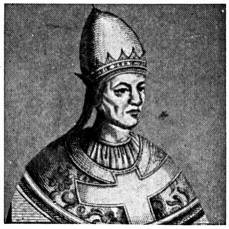 Hildebrand was born of poor parents at Soana in Tuscany.
Educated at a Roman monastery and the Lateran school, he became a monk. Pious,
bursting with energy, and gifted with administrative ability, the little monk
was to become a great pope. When his old teacher John Gratian, became Pope
Gregory VI, he took Hildebrand into his service and ordered him to clean up the
city, tormented by violence and barefaced robbery, grim heirlooms of Benedict
IX's disorderly pontificate. The young monk organized a police force which
knocked some order into the Roman lordlings. At Gregory's resignation Hildebrand
followed him into Germany. At Gregory's death, he retired to Cluny. Pope Leo IX
took Hildebrand back to Rome and henceforth he served as a strong right arm to
the reforming popes. After Alexander II died, the demand for Hildebrand was too
great to be resisted. He was consecrated as Gregory VII on June 30, 1073. With
St. Gregory VII the fight against abuses reached a new pitch of intensity. This
devout, very sincere man faced squarely the sad condition of the Church. No
fanatic, he concentrated on the worst abuses. Now the root of abuse was the way
kings and lords appointed bishops and abbots by lay investiture. Gregory swung
the ax at this root by absolutely banning lay investiture at a Roman synod in
1075.
Hildebrand was born of poor parents at Soana in Tuscany.
Educated at a Roman monastery and the Lateran school, he became a monk. Pious,
bursting with energy, and gifted with administrative ability, the little monk
was to become a great pope. When his old teacher John Gratian, became Pope
Gregory VI, he took Hildebrand into his service and ordered him to clean up the
city, tormented by violence and barefaced robbery, grim heirlooms of Benedict
IX's disorderly pontificate. The young monk organized a police force which
knocked some order into the Roman lordlings. At Gregory's resignation Hildebrand
followed him into Germany. At Gregory's death, he retired to Cluny. Pope Leo IX
took Hildebrand back to Rome and henceforth he served as a strong right arm to
the reforming popes. After Alexander II died, the demand for Hildebrand was too
great to be resisted. He was consecrated as Gregory VII on June 30, 1073. With
St. Gregory VII the fight against abuses reached a new pitch of intensity. This
devout, very sincere man faced squarely the sad condition of the Church. No
fanatic, he concentrated on the worst abuses. Now the root of abuse was the way
kings and lords appointed bishops and abbots by lay investiture. Gregory swung
the ax at this root by absolutely banning lay investiture at a Roman synod in
1075.
The stage was set for the clash with King Henry IV. Henry had talked fair,
but continued to act evilly. Cencius, a Roman noble friendly to the king, broke
in on Gregory's Christmas Mass and carried him a prisoner to his tower. But the
Romans swarmed so angrily around his tower that the rascal lord quickly released
the outraged Pope. Gregory then summoned Henry under pain of excommunication to
appear before a Roman synod to answer charges. Henry's answer was to hold his
own synod at Worms and have his subservient bishops condemn Gregory. The Pope
excommunicated Henry and released his subjects from their allegiance. Saxony
rose in arms and Henry's throne quaked when the nobles of Germany gathered at
Tribur in October 1076. Gregory's legates persuaded the nobles to give Henry a
chance to repent before deposing him. A national diet under the Pope's
presidency was summoned at Augsburg for 1077.
Henry, knowing his unpopularity
with many nobles, had no wish to face this assembly. He hurried over the Alps
before Gregory could reach Germany. As a suppliant he appeared before the castle
of Canossa where Gregory had retired. Cleverly the King stood shivering in a
penitential garb while Countess Matilda, the Pope's hostess, and St. Hugh of
Cluny pleaded for mercy. Gregory knew he should await the Augsburg meeting, but
he had been jockeyed by Henry into a position where he simply had to absolve the
king. Once absolved, Henry went back to his old ways. He set up an antipope, the
abuse-loving Guibert of Ravenna. He defeated the German nobles, captured Rome,
and installed his creature in the Lateran as Clement III. Gregory, besieged in
the Castle of St. Angelo, was rescued by the Normans. But soon he had to leave
Rome. Worn out the brave old saint died at Salerno in 1085. "I have loved
justice and hated iniquity, therefore I die in exile," he said; but he had paved
the way for a better future. He was canonized by Benedict XIII in 1728.
Excerpted from "Popes
Through the Ages" by Joseph Brusher, S.J.

